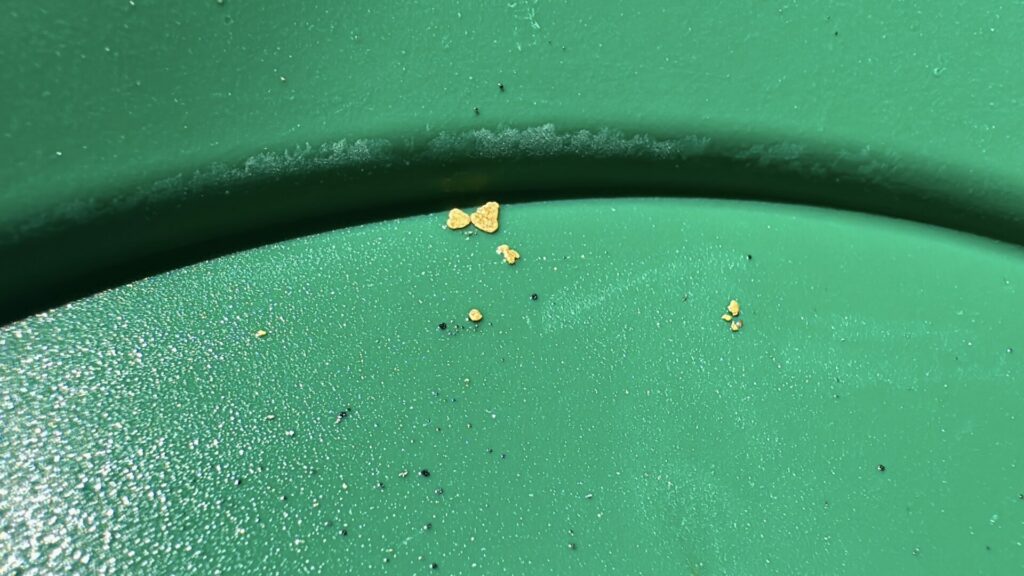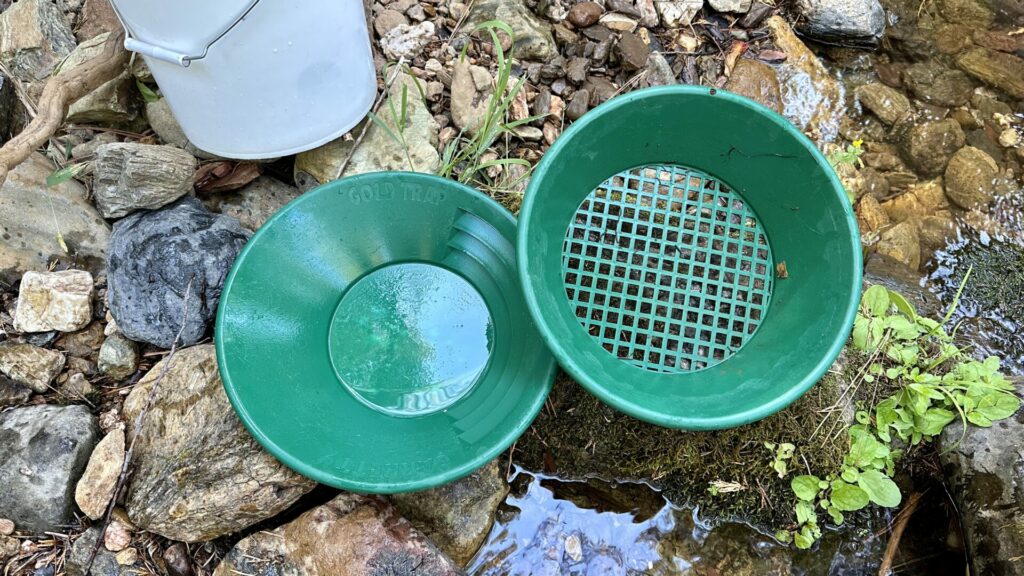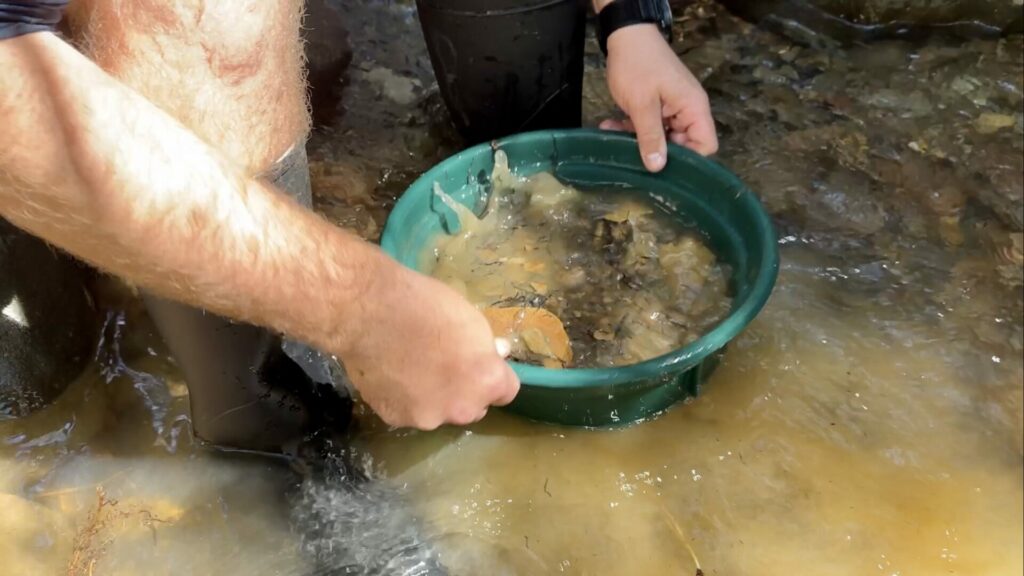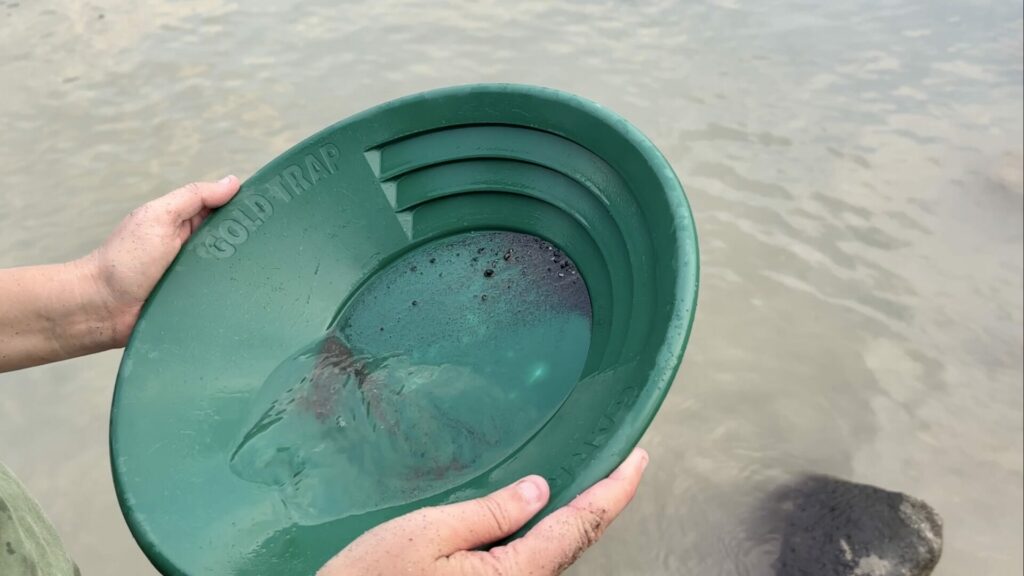Table of Contents Show
Many tourists hope to strike it rich by panning for gold in Alaska. At roughly $1,900 per ounce, you don’t have to find much to rake in the bucks. Unfortunately, it’s not as easy as it looks, and coming up empty-handed is common.
Today, we’re telling beginners everything they need to know when it comes to panning for gold because using the proper tools and techniques will give you the best shot. So grab your gear, and let’s get started!
What Is Panning for Gold?
Panning for gold is uncovering tiny particles of gold resting in rivers and streams. The user uses a shallow pan made from plastic or metal to scoop up a mixture of sediment and water.
They use a controlled motion to swirl the water and the contents in the pan. Since gold is a very heavy mineral, it sinks to the bottom.
The user continues swirling as they separate the dirt, rocks, and other materials. If there are gold flakes in the sediment, they’ll sit at the bottom of the pan. The user can then collect the treasure using a water dropper or other tool.
This fun and exciting activity also allows you to spend time outdoors. Do most people strike it rich? Absolutely not. However, many find it slightly addicting. Like in Vegas, you never know when it’ll be your lucky day.

Is Panning for Gold Legal in Alaska?
You can legally pan for gold in Alaska. However, even though you’ll likely be panning recreationally, you must follow certain rules and regulations. You could be in serious legal trouble if you don’t follow these rules.
These regulations protect the environment, preserve ownership rights, and ensure safety. The legality of panning for gold will largely depend on the location. As a result, you’ll want to get familiar with the legal requirements specific to the area you hope to go panning.
When Is the Best Time to Go Gold Panning in Alaska?
The best time to try gold panning will be from May through September. Remember, you’ll be standing in a stream or river most of the time. While the waters may not be overly warm, they’re much more tolerable during these months. Temperatures during this period tend to increase, and there’s not a significant risk of snow or extreme cold.
It’s important to remember that this is Alaska’s peak tourist season. Unfortunately, if you think you’re going to be the only one testing their luck, you’re most likely not.
Finding a secluded spot can be challenging, and many popular locations can get crowded. Not only will it make navigating the creek or river hard, but it will also be harder to enjoy the natural setting.

How to Get Started Panning for Gold in Alaska
Want to start panning? Luckily, it’s easy for beginners to get started finding gold. However, while we can’t promise you’ll hit the jackpot, we can ensure you’re in for an exciting experience. Let’s dive in!
Research and Choose Your Location
You wouldn’t go fishing if you knew there weren’t any fish in the water, would you? Panning for gold in Alaska is the same as fishing. You don’t want to waste your time in an area if you won’t find any gold. As a result, it’s essential to research and choose your location wisely.
You can search for helpful information in books, Facebook groups, and websites. You’ll learn about the regions, rivers, and creeks known for housing rich minerals. Form a friendship with a local, and they may let you try your luck on land they’ve claimed.
Remember that the terrain in Alaska is incredibly rugged. Accessing some areas may require strenuous hiking, boating, or even flying. Don’t go overboard or put yourself in danger, especially when just starting.
Keep in Mind: Should you be on the look out for the Alaskan Giant Polar Bear? Let’s dive in and see!

Get Permits and Permission
One of the worst things you can do is to set up shop anywhere and start panning. As we mentioned, there are stringent rules and regulations regarding panning for gold in Alaska.
Some areas may require a permit before panning, while others may not. Check with the Alaska Department of Natural Resources or the U.S. Bureau of Land Management. They’ll help ensure you stay on the right side of the law and not end up in hot water.
Obtaining approval may require filling out an application, paying a fee, and then waiting for approval. As a result, you don’t want to wait until the last minute, especially if you’re trying to do this on your own. Don’t worry; we’ll share some great options to help you get started and stay legal later.
Gather Equipment
Luckily, getting started panning for gold in Alaska requires limited equipment. You need a gold pan, a snuffer bottle, tweezers, a shovel, and a small backpack to carry your gear.
The snuffer bottle helps suction small gold flakes and nuggets from the pan. If you don’t use one, you risk dropping anything you find back into the water. You can transfer the minerals from your pan into a vial for storage.
As you gain experience, you can start adding to your equipment. A classifier helps you separate the larger rocks and debris from the sediment, and you’ll eventually need waterproof boots or waders, knee pads, and gloves to provide comfort.
Keep in Mind: Alaska isn’t the only state you can pan for gold. You can still prospect at these Gold Mines in Arizona!

Learn Panning Techniques
Learning proper panning techniques maximizes your chances of finding gold. First, you fill your pan with gravel, sand, and sediment from the riverbed. You then submerge the pan to add some water to the mixture.
By holding the pan at a slight angle and shaking it, it loosens up the mixture. The lighter materials rise to the top, while heavier items sink. You continue to swirl and shake the pan as you eliminate larger matter from the pan. You continue the process until only the finest sediment remains in the bottom of the pan.
Use the light from the sun to see shimmers from the gold reflecting the light. You then use tweezers and the snuffer bottle to gather your findings and store them in a vial. Now, rinse the pan out and repeat the entire process.
Start Panning
Once you have your technique down, start panning. However, you must be patient. Just like fishing, there will be plenty of times when you have little luck. If it’s not your day, you may not find a single flake of gold.
The more you can go panning for gold in Alaska, the more you’ll hone your techniques and skills. Ultimately, even if you didn’t strike it rich, you spent time in nature. There are worse ways you could spend your time.

Consider Hiring a Guide
If heading out for the first time, consider hiring a guide or signing up for an excursion. These individuals or vendors will do everything they can to help educate you and help you at least find a few flakes.
Additionally, they’re very familiar with the rules and regulations. They’ll know exactly what you need to do and where you can go to avoid legal issues. Many of these establishments own mining claims on lands, which gives them the sole right to extract minerals.
Unfortunately, these can be rather pricey, but they can be worth it. After a day of panning with a guide, you’ll have the confidence and knowledge to try on your own. Your guide may even recommend a few places you can go panning.
Will You Strike It Rich Panning for Gold in Alaska?
It’s fun to think about discovering a massive gold nugget sitting at the bottom of your pan. Unfortunately, the odds aren’t great that you will retire on your findings while panning for gold in Alaska.
Finding anything valuable will take patience, persistence, and a bit of luck. However, that’s part of the thrill and why many can’t stop once they start.
Have you ever gone panning for gold while visiting Alaska?






